
Sabatinca chrysargyra is a species of moth belonging to the family Micropterigidae. It was described by Edward Meyrick in 1886 and is endemic to New Zealand. It can be found from Franz Josef Glacier / Kā Roimata o Hine Hukatere south but only on the western side of the South Island. Adults are on the wing from the beginning of October until the middle of January. Larvae likely feed on foliose liverworts and have been found on species in the genus Plagiochila. The adult moths live in a range of habitats preferring sunny open spaces in forests or snow-tussock grasslands that can range in altitude from near sea level up to 1,230 m. This species is very similar in appearance to Sabatinca aemula and dissection of genitalia is required to distinguish between the two species.

Sabatinca quadrijuga is a species of moth belonging to the family Micropterigidae. This species is endemic to New Zealand and is found in the Dunedin area and in Southland. The range of S. quadrijuga overlaps with the range of S. caustica.S. quadrijuga was first scientifically described by Edward Meyrick in 1912. As a result of its predominantly black forewings this species looks similar to a small caddisfly. The adults of this species are on the wing from September to November. Larvae feed on leafy liverwort species and the adults likely feed on fern spores or sedge pollen. The species prefers to live in well lit but damp mossy habitats. The nearest relative of S. quadrijuga is S. aurantissima.
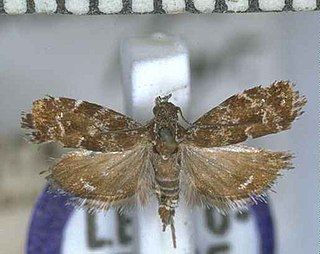
Asterivora analoga is a moth of the family Choreutidae. It is endemic to New Zealand and has been observed in both the North and South Islands. Adults are on the wing in December and January.

Asterivora barbigera is a moth in the family Choreutidae. It is endemic to New Zealand and is found in the southern half of the South Island. It inhabits open mountain sides and adults are on the wing in November to January.

Glaucocharis chrysochyta is a species of moth in the family Crambidae. This species was first described by Edward Meyrick in 1882. It is endemic to New Zealand and is found throughout the country. It inhabits native forest. Larvae appear to feed on moss and likely pupate there. Adult moths are on the wing from November to March. They fly at night and are attracted to light.

Heterocrossa adreptella is a moth of the Carposinidae family. This species was long considered the New Zealand raspberry budmoth however this was a taxonomic misinterpretation of the type material used to describe this species. This error was corrected in 1988 with the New Zealand raspberry budmoth giving its own species name Heterocrossa rubophaga. H. adreptella is endemic to New Zealand and has been collected in the Wellington Botanic Garden and been observed resting on mānuka branches.

Heterocrossa contactella is a species of moth in the family Carposinidae. It is endemic to New Zealand and can be observed in both the North and South Islands. The preferred habitat of this species is native forest and scrub, especially where Leptospermum shrubs are found. Adults are on the wing in December and January.
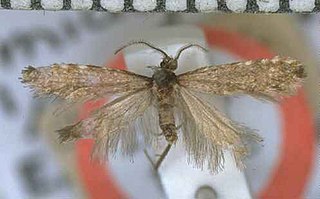
Reductoderces microphanes is a moth of the family Psychidae. This species is endemic to New Zealand. R. microphanes is a bagworm moth and its larvae likely feed on lichen or algae. Historically there has been some confusion over the identification of this species with George Hudson mistakenly describing and illustrating unnamed species and then attributing those descriptions and illustrations to this species. Charles Edwin Clarke discussed this species stating that it and its close relatives were active and able to be collected in damp mists before sunrise.

Orocrambus abditus is a moth of the family Crambidae. It was first described by Alfred Philpott in 1924. It is endemic to New Zealand and can be found in Marlborough, Arthur's Pass, and in Canterbury. The species inhabits grassland including tussock grassland and shrubland. Larvae have been collected in October and the adults of this species are on the wing from October to March.

Glaucocharis elaina is a species of moth in the family Crambidae. This species was described by Edward Meyrick in 1882. It is endemic to New Zealand and is found throughout the North and South Island with the exception of the extreme south of the South Island.

Glaucocharis auriscriptella, also known as the yellow silverling, is a moth in the family Crambidae. It was first described by Francis Walker in 1864 and is endemic to New Zealand. This species can be found in the North, South, Stewart and Great Barrier Islands. The preferred habitat of this moth is lowland and subalpine native forest as well as wetlands. The larvae feed on moss. The adult moth is day flying and is on the wing from November to February. It can be observed in colonies and can be attracted to light at night. This species likely has only one generation per year.
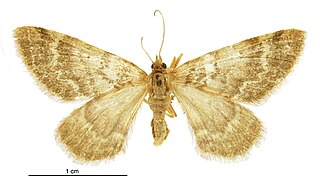
Asaphodes aphelias is a species of moth in the family Geometridae. It is endemic to New Zealand and has been observed in Fiordland. This species inhabits damp native scrub and has been observed in upland wetlands at altitudes of between 800 and 1100 m. Adults are on the wing in February but the female of this species is unusual as it has narrow fore and hind wings.
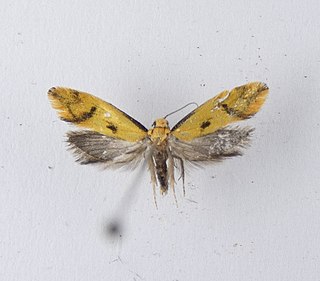
Tingena actinias is a species of moth in the family Oecophoridae. It is endemic to New Zealand and is found on the North and South Islands. The larvae of this species are leaf litter feeders. The preferred habitat of this species is shrubland and it has also been observed in gumland heaths and in beech forest.

Tingena crotala is a species of moth in the family Oecophoridae. It is endemic to New Zealand and is found both in the North and South Islands. This species inhabits native forest and is on the wing in November and December.
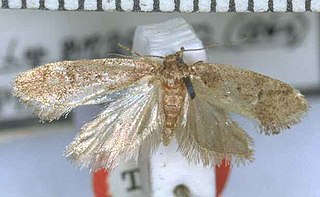
Tingena innotella is a species of moth in the family Oecophoridae. It is endemic to New Zealand and is found in both the North and South Islands. This species inhabits open native forest or scrubland and adults are on the wing from December to March. T. innotella appears to have an affinity for the silver tree fern.

Tingena letharga is a species of moth in the family Oecophoridae. It is endemic to New Zealand and has been observed in Otago. Adults are on the wing in December and January.

Trachypepla ingenua is a moth of the family Oecophoridae first described by Edward Meyrick in 1911. It is endemic to New Zealand and has been collected in both the North and South Islands. This species is one of the larger in the genus Trachypepla and the colouration of the adults imitates bird droppings. The preferred habitat of T. ingenua is native forest and adults are on the wing from December to February.

Trachypepla minuta is a moth of the family Oecophoridae first described by Alfred Philpott in 1931. It is endemic to New Zealand and has been collected in Auckland. Adults of this species are on the wing in December. It is distinguishable from similar species as it is smaller in size and darker in appearance than other species in the genus Trachypepla.

Trachypepla protochlora is a moth of the family Oecophoridae first described by Edward Meyrick in 1883. It is endemic to New Zealand and is found in both the North and South Islands. The preferred habitat of this species is native forest and adults are on the wing from October until February. Adults can be variable in their green shaded colour as well as in the intensity of markings on their forewings. The greenish ground colouration of this moth ensures they are well camouflaged when at rest on green mosses and lichens.
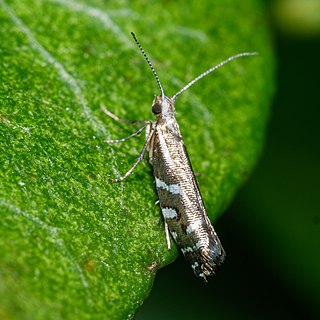
Chrysorthenches glypharcha is a species of moth in the family Plutellidae. It was first described by Edward Meyrick in 1919. It is endemic to New Zealand and is found in the North and South Islands. This species inhabits native forest with Podocarpus trees present. The larva and pupa of this species is currently unknown but the adults are on the wing in February, October and November. The adult moths are associated with Podocarpus totara and Podocarpus laetus.






















